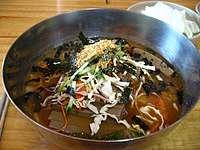Memil-muk
 | |
| Alternative names | Buckwheat jelly |
|---|---|
| Type | Muk |
| Place of origin | Korea |
| Associated cuisine | Korean cuisine |
| Main ingredients | Buckwheat starch |
| Korean name | |
| Hangul | 메밀묵 |
|---|---|
| Revised Romanization | memil-muk |
| McCune–Reischauer | memil-muk |
| IPA | [me.mil.muk̚] |
Memil-muk (메밀묵) or buckwheat jelly is a light gray-brown muk (jelly) made from buckwheat starch.[1] It is commonly served as banchan (a side dish accompanying rice) as well as anju (food accompanying alcoholic drinks).
In post-war Korea, from the mid to late-20th century, memil-muk along with chapssal-tteok (glutinous rice cakes) was widely served as yasik (late-night snack) by street vendors.[1][2][3] In modern times, it is popular as a diet food.[1]
Along with other buckwheat dishes, it is a local specialty of Gangwon Province, especially Bongpyeong Township in Pyeongchang County.[4]
Preparation[edit]
Unhulled whole buckwheat grains are soaked in water (to reduce bitterness). Soaked grains are then ground in maetdol (millstone) and sieved.[4] The skins are discarded, and the remaining liquid is set aside to allow it to separate into layers.[4] The upper layer, consisting of clear water, is discarded. The lower layer, consisting of settled buckwheat starch, is boiled with constant stirring.[4] When cooled, the mixture sets to form a jelly-like substance, muk.[4]
Memil-muk is most commonly eaten as memil-muk-muchim (메밀묵무침; "buckwheat jelly salad"), a banchan (side dish) in which chunks of memil-muk are mixed with chopped kimchi, ground toasted sesame seeds and soy sauce.[1][2] In Gangwon Province, memil-muk is used in jesa (ancestral rites) for deceased ancestors.[2] In summer, memil-muk-sabal (메밀묵사발; "cold buckwheat jelly soup") is made with cold kimchi broth, while in winter, memil-muk is served in hot jangguk (soy sauce-based beef broth).[2]
In Yeongju, some houses are still made in the traditional way and eat Muk-bap(묵밥).[5]
In folklore[edit]
In ancient times, memil-muk was thought to be irresistible to dokkaebi (Korean goblins).[6]
Memil-muk is offered in dokkaebi-gut, a gut (shamanistic ritual performed by a mu shaman) for chasing away dokkaebi, which were believed to be the causes of contagious diseases.[7] Other rituals with similar purpose, such as dokkaebi-je, a jesa (Confucian ritual, held in households), and dokkaebi-gosa, a gosa (shamanistic or Buddhist household ritual, held in households), also include the offering of memil-muk.[7]
In popular culture[edit]
In the manhwa Dokebi Bride, the use of memil-muk to call on dokebi is an important plot device.[citation needed]
Gallery[edit]
-
Memil-muk-muchim (buckwheat jelly salad)
-
Memil-muk-sabal (cold buckwheat jelly soup)
-
Blocks of memil-muk (buckwheat jelly)
See also[edit]
- Dotori-muk, acorn jelly
- Nokdu-muk, mung bean jelly
- Konnyaku, Japanese konjac jelly
- List of buckwheat dishes
References[edit]
- ^ a b c d Koo, Chun-sur (Autumn 2003). "Muk : A Refreshing Taste to Whet the Appetite". Koreana. Vol. 17, no. 3. Archived from the original on 31 August 2017. Retrieved 4 February 2012.
- ^ a b c d 정, 혜경. "memil-muk" 메밀묵. Encyclopedia of Korean Culture (in Korean). Academy of Korean Studies. Retrieved 19 June 2017.
- ^ Neff, Robert (6 January 2016). "[Joseon Images] Snack peddlers popular to Westerners in 19th century". The Korea Times. Retrieved 19 June 2017.
- ^ a b c d e "memil-muk" 메밀묵. Doopedia (in Korean). Doosan Corporation. Retrieved 19 June 2017.
- ^ "묵밥". korean.visitkorea.or.kr (in Korean). Retrieved 2018-04-21.
- ^ Jones, Brooke (28 October 2016). "Friday Frights: A Local Ghoul Glossary". Honolulu. Retrieved 19 June 2017.
- ^ a b Kim, Jongdae. "Dokkaebigut" 도깨비굿 [Goblin Ritual]. Encyclopedia of Korean Folk Culture. National Folk Museum of Korea. Retrieved 19 June 2017.



